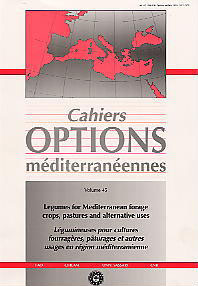| Article précédent | p. 63-67 | Article suivant |
Comparisons among different plant breeding approaches applied to red clover
Six hundred and six healthy plants were randomly collected from the Sardinian red clover ecotype 'Gioscari' and submitted to three different breeding programs: Mass Selection 2 (MS2), Half Sib Family Selection (HSFS) and Half Sib Progeny Test (HSPT). Two cycles of MS2 selection and 1 cycle of HSFS did not produce an increase in red clover Dry Matter Yield (DMY) even if high Selection Differentials were applied; on the contrary, 1 cycle of HSPT gave rise to a significant response. The results of the breeding activities were not evident for total DMY (i.e. including weeds), but just for red clover DMY. Therefore the selection gave rise to a material able to increase its percentage in the botanical composition of the forage with respect to the initial material and, by this way, capable of contrasting weed growth under dense stand condition. The results show that the choice of the breeding procedure has to be carefully considered at the beginning of a new breeding programme in a forage species such as red clover.
- [ Afficher ]
- [ Télécharger ]
- [ Exporter la citation ]
Vous pouvez télécharger la citation au format :
- [ Imprimer ]
-
Mots-clés
AMELIORATION DES PLANTES, PATURAGES, TREFLE VIOLETCiter cet article
Ledda L., Roggero P.P., Veronesi F. Comparisons among different plant breeding approaches applied to red clover. In : Sulas L. (ed.). Legumes for Mediterranean forage crops, pastures and alternative uses . Zaragoza : CIHEAM, 2000. p. 63-67. (Cahiers Options Méditerranéennes; n. 45). 10. Meeting of the Mediterranean Sub-Network of the FAO-CIHEAM Inter-Regional Cooperative Research and Development Network on Pastures and Fodder Crops, 2000/04/04-09, Sassari (Italy). http://om.ciheam.org/om/pdf/c45/00600170.pdf



